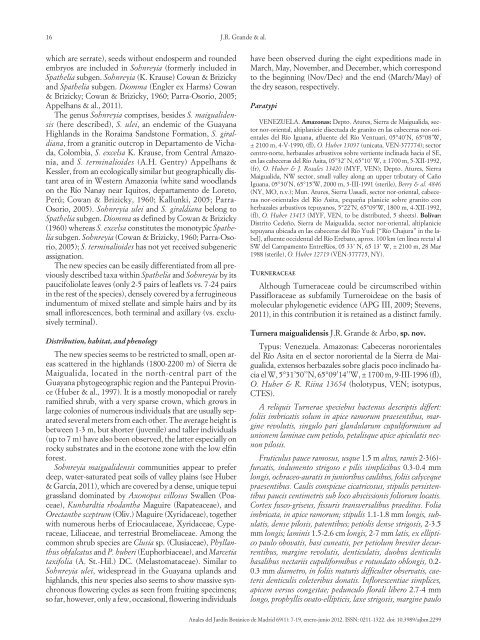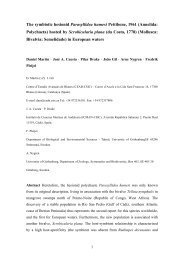Botanical novelties from Sierra de Maigualida, southern ... - CSIC
Botanical novelties from Sierra de Maigualida, southern ... - CSIC
Botanical novelties from Sierra de Maigualida, southern ... - CSIC
Create successful ePaper yourself
Turn your PDF publications into a flip-book with our unique Google optimized e-Paper software.
16<br />
J.R. Gran<strong>de</strong> & al.<br />
which are serrate), seeds without endosperm and roun<strong>de</strong>d<br />
embryos are inclu<strong>de</strong>d in Sohnreyia (formerly inclu<strong>de</strong>d in<br />
Spathelia subgen. Sohnreyia (K. Krause) Cowan & Brizicky<br />
and Spathelia subgen. Diomma (Engler ex Harms) Cowan<br />
& Brizicky; Cowan & Brizicky, 1960; Parra-Osorio, 2005;<br />
Appelhans & al., 2011).<br />
The genus Sohnreyia comprises, besi<strong>de</strong>s S. maiguali<strong>de</strong>nsis<br />
(here <strong>de</strong>scribed), S. ulei, an en<strong>de</strong>mic of the Guayana<br />
Highlands in the Roraima Sandstone Formation, S. giraldiana,<br />
<strong>from</strong> a granitic outcrop in Departamento <strong>de</strong> Vichada,<br />
Colombia, S. excelsa K. Krause, <strong>from</strong> Central Amazonia,<br />
and S. terminalioi<strong>de</strong>s (A.H. Gentry) Appelhans &<br />
Kessler, <strong>from</strong> an ecologically similar but geographically distant<br />
area of in Western Amazonia (white sand woodlands<br />
on the Río Nanay near Iquitos, <strong>de</strong>partamento <strong>de</strong> Loreto,<br />
Perú; Cowan & Brizicky, 1960; Kallunki, 2005; Parra-<br />
Osorio, 2005). Sohnreyia ulei and S. giraldiana belong to<br />
Spathelia subgen. Diomma as <strong>de</strong>fined by Cowan & Brizicky<br />
(1960) whereas S. excelsa constitutes the monotypic Spathelia<br />
subgen. Sohnreyia (Cowan & Brizicky, 1960; Parra-Osorio,<br />
2005); S. terminalioi<strong>de</strong>s has not yet received subgeneric<br />
assignation.<br />
The new species can be easily differentiated <strong>from</strong> all previously<br />
<strong>de</strong>scribed taxa within Spathelia and Sohnreyia by its<br />
paucifoliolate leaves (only 2-5 pairs of leaflets vs. 7-24 pairs<br />
in the rest of the species), <strong>de</strong>nsely covered by a ferrugineous<br />
indumentum of mixed stellate and simple hairs and by its<br />
small inflorescences, both terminal and axillary (vs. exclusively<br />
terminal).<br />
Distribution, habitat, and phenology<br />
The new species seems to be restricted to small, open areas<br />
scattered in the highlands (1800-2200 m) of <strong>Sierra</strong> <strong>de</strong><br />
<strong>Maigualida</strong>, located in the north-central part of the<br />
Guayana phytogeographic region and the Pantepui Pro vin -<br />
ce (Huber & al., 1997). It is a mostly monopodial or rarely<br />
ramified shrub, with a very sparse crown, which grows in<br />
large colonies of numerous individuals that are usually separated<br />
several meters <strong>from</strong> each other. The average height is<br />
between 1-3 m, but shorter (juvenile) and taller individuals<br />
(up to 7 m) have also been observed, the latter especially on<br />
rocky substrates and in the ecotone zone with the low elfin<br />
forest.<br />
Sohnreyia maiguali<strong>de</strong>nsis communities appear to prefer<br />
<strong>de</strong>ep, water-saturated peat soils of valley plains (see Huber<br />
& García, 2011), which are covered by a <strong>de</strong>nse, unique tepui<br />
grassland dominated by Axonopus villosus Swallen (Poa-<br />
ceae), Kunhardtia rhodantha Maguire (Rapateaceae), and<br />
Orectanthe sceptrum (Oliv.) Maguire (Xyridaceae), together<br />
with numerous herbs of Eriocaulaceae, Xyridaceae, Cype -<br />
raceae, Liliaceae, and terrestrial Bromeliaceae. Among the<br />
common shrub species are Clusia sp. (Clusiaceae), Phyllanthus<br />
obfalcatus and P. huberi (Euphorbiaceae), and Marcetia<br />
taxifolia (A. St.-Hil.) DC. (Melastomataceae). Similar to<br />
Sohnreyia ulei, wi<strong>de</strong>spread in the Guayana uplands and<br />
highlands, this new species also seems to show massive synchronous<br />
flowering cycles as seen <strong>from</strong> fruiting specimens;<br />
so far, however, only a few, occasional, flowering individuals<br />
have been observed during the eight expeditions ma<strong>de</strong> in<br />
March, May, November, and December, which correspond<br />
to the beginning (Nov/Dec) and the end (March/May) of<br />
the dry season, respectively.<br />
Paratypi<br />
VENEZUELA. Amazonas: Depto. Atures, <strong>Sierra</strong> <strong>de</strong> <strong>Maigualida</strong>, sector<br />
nor-oriental, altiplanicie disectada <strong>de</strong> granito en las cabeceras nor-orientales<br />
<strong>de</strong>l Río Iguana, afluente <strong>de</strong>l Río Ventuari, 05°40’N, 65°08’W,<br />
± 2100 m, 4-V-1990, (fl), O. Huber 13097 (unicata, VEN-377774); sector<br />
centro-norte, herbazales arbustivos sobre vertiente inclinada hacia el SE,<br />
en las cabeceras <strong>de</strong>l Río Asita, 05°32’ N, 65°10’ W, ± 1700 m, 5-XII-1992,<br />
(fr), O. Huber & J. Rosales 13420 (MYF, VEN); Depto. Atures, <strong>Sierra</strong><br />
<strong>Maigualida</strong>, NW sector, small valley along an upper tributary of Caño<br />
Iguana, 05°30’N, 65°15’W, 2000 m, 3-III-1991 (sterile), Berry & al. 4846<br />
(NY, MO, n.v.); Mun. Atures, <strong>Sierra</strong> Uasadi, sector nor-oriental, cabe ce -<br />
ras nor-orientales <strong>de</strong>l Río Asita, pequeña planicie sobre granito con<br />
herbazales arbustivos tepuyanos, 5°22’N, 65°09’W, 1800 m, 4-XII-1992,<br />
(fl), O. Huber 13415 (MYF, VEN, to be distributed, 5 sheets). Bolívar:<br />
Distrito Ce<strong>de</strong>ño, <strong>Sierra</strong> <strong>de</strong> <strong>Maigualida</strong>, sector nor-oriental, altiplanicie<br />
tepuyana ubicada en las cabeceras <strong>de</strong>l Río Yudi [“Río Chajura” in the label],<br />
afluente occi<strong>de</strong>ntal <strong>de</strong>l Río Erebato, aprox. 100 km (en línea recta) al<br />
SW <strong>de</strong>l Campamento EntreRíos, 05 33’ N, 65 13’ W, ± 2100 m, 28 Mar<br />
1988 (sterile), O. Huber 12719 (VEN-377775, NY).<br />
TURNERACEAE<br />
Although Turneraceae could be circumscribed within<br />
Passifloraceae as subfamily Turneroi<strong>de</strong>ae on the basis of<br />
molecular phylogenetic evi<strong>de</strong>nce (APG III, 2009; Stevens,<br />
2011), in this contribution it is retained as a distinct family.<br />
Turnera maiguali<strong>de</strong>nsis J.R. Gran<strong>de</strong> & Arbo, sp. nov.<br />
Typus: Venezuela. Amazonas: Cabeceras nororientales<br />
<strong>de</strong>l Río Asita en el sector nororiental <strong>de</strong> la <strong>Sierra</strong> <strong>de</strong> Maigua<br />
lida, extensos herbazales sobre glacis poco inclinado hacia<br />
el W, 5°31’50’’N, 65°09’14’’W, ± 1700 m, 9-III-1996 (fl),<br />
O. Huber & R. Riina 13654 (holotypus, VEN; isotypus,<br />
CTES).<br />
A reliquis Turnerae speciebus hactenus <strong>de</strong>scriptis differt:<br />
foliis imbricatis solum in apice ramorum praesentibus, mar -<br />
gine revolutis, singulo pari glandularum cupulifor mium ad<br />
unionem laminae cum petiolo, petalisque apice apiculatis necnon<br />
pilosis.<br />
Fruticulus pauce ramosus, usque 1.5 m altus, ramis 2-3(6)-<br />
furcatis, indumento strigoso e pilis simplicibus 0.3-0.4 mm<br />
longis, ochraceo-auratis in junioribus caulibus, foliis calyceque<br />
praesentibus. Caulis conspicue cicatricosus, stipulis persistentibus<br />
paucis centimetris sub loco abscissionis foliorum locatis.<br />
Cortex fusco-griseus, fissuris transversalibus praeditus. Folia<br />
imbricata, in apice ramorum; stipulis 1.1-1.8 mm longis, subulatis,<br />
<strong>de</strong>nse pilosis, patentibus; petiolis <strong>de</strong>nse strigosis, 2-3.5<br />
mm longis; laminis 1.5-2.6 cm longis, 2-7 mm latis, ex elliptico<br />
paulo obovatis, basi cuneatis, per petiolum breviter <strong>de</strong>currentibus,<br />
margine revolutis, <strong>de</strong>nticulatis, duobus <strong>de</strong>nticulis<br />
basalibus nectariis cupuliformibus e rotundato oblongis, 0.2-<br />
0.3 mm diametro, in foliis maturis difficulter observatis, caeteris<br />
<strong>de</strong>nticulis coleteribus donatis. Inflorescentiae simplices,<br />
apicem versus congestae; pedunculo florali libero 2.7-4 mm<br />
longo, prophyllis ovato-ellipticis, laxe strigosis, margine paulo<br />
Anales <strong>de</strong>l Jardín Botánico <strong>de</strong> Madrid 69(1): 7-19, enero-junio 2012. ISSN: 0211-1322. doi: 10.3989/ajbm.2299
















